Validation of a Simulated Commercial Plain Bagel Baking Process and Thermal Resistance Characterization of a 5-Strain Shiga Toxin-Producing Escherichia coli When Introduced via Flour
Abstract
1. Introduction
2. Materials and Methods
2.1. Bagel Dough Preparation
2.2. Experimental Design
2.3. STEC Serovars
2.4. Master Inoculum Preparation
2.5. Flour Inoculation
2.6. Plain Bagel Dough Boiling and Baking
2.7. Water Activity (aw), pH, and Humidity Ratio
2.8. D- and z-Value Determination
2.9. Microbial Analysis
3. Results
3.1. Validation of Bagel Boiling/Baking to Control STEC
3.2. D- and z-Values of STEC in Bagel Dough
4. Discussion
5. Conclusions
Author Contributions
Funding
Institutional Review Board Statement
Informed Consent Statement
Data Availability Statement
Acknowledgments
Conflicts of Interest
References
- 2021 E. coli Outbreak Linked to Cake Mix—Investigation Details. 2021. Available online: https://archive.cdc.gov/www_cdc_gov/ecoli/2021/o121-07-21/details.html (accessed on 9 November 2024).
- Gill, A.; McMahon, T.; Dussault, F.; Petronella, N. Shiga toxin-producing Escherichia coli survives storage in wheat flour for two years. Food Microbiol. 2020, 87, 103380. [Google Scholar] [CrossRef] [PubMed]
- Hines, I.S.; Jurkiw, T.; Nguyen, E.; Ferguson, M.; Solaiman, S.; Reed, E.; Hoffmann, M.; Zheng, J. Persistence comparison of two Shiga-toxin producing Escherichia coli (STEC) serovars during long-term storage and thermal inactivation in various wheat flours. PLoS ONE 2024, 19, e0299922. [Google Scholar] [CrossRef] [PubMed] [PubMed Central]
- Jung, J.; Harris, L. Survival of Salmonella and Shiga toxin–producing Escherichia coli during tempering of wheat berries. Food Control 2023, 144, 10943. [Google Scholar]
- Michael, M.; Acuff, J.C.; Vega, D.; Sekhon, A.S.; Channaiah, L.H.; Phebus, R.K. Survivability and thermal resistance of Salmonella and Escherichia coli O121 in wheat flour during extended storage of 360 days. Int. J. Food Microbiol. 2022, 362, 109495, Erratum in Int. J. Food Microbiol. 2023, 390, 110123. [Google Scholar] [CrossRef] [PubMed]
- Forghani, F.; Li, S.; Zhang, S.; Mann, D.A.; Deng, X.; den Bakker, H.C.; Diez-Gonzalez, F. Salmonella enterica and Escherichia coli in Wheat Flour: Detection and Serotyping by a Quasimetagenomic Approach Assisted by Magnetic Capture, Multiple-Displacement Amplification, and Real-Time Sequencing. Appl. Environ. Microbiol. 2020, 86, e00097-20. [Google Scholar] [CrossRef] [PubMed] [PubMed Central]
- Michael, M.; Acuff, J.; Lopez, K.; Vega, D.; Phebus, R.; Thippareddi, H.; Channaiah, L.H. Comparison of survival and heat resistance of Escherichia coli O121 and Salmonella in muffins. Int. J. Food Microbiol. 2020, 317, 108422. [Google Scholar] [CrossRef] [PubMed]
- Rangel, J.M.; Sparling, P.H.; Crowe, C.; Griffin, P.M.; Swerdlow, D.L. Epidemiology of Escherichia coli O157:H7 outbreaks, United States, 1982-2002. Emerg. Infect Dis. 2005, 11, 603–609. [Google Scholar] [CrossRef] [PubMed] [PubMed Central]
- Söderlund, R.; Flink, C.; Aspán, A.; Eriksson, E. Shiga toxin-producing Escherichia coli (STEC) and atypical enteropathogenic E. coli (aEPEC) in Swedish retail wheat flour. Access Microbiol. 2023, 5, acmi000577.v3. [Google Scholar] [CrossRef] [PubMed] [PubMed Central]
- Crowe, S.J.; Bottichio, L.; Shade, L.N.; Whitney, B.M.; Corral, N.; Melius, B.; Arends, K.D.; Donovan, D.; Stone, J.; Allen, K.; et al. Shiga Toxin-Producing E. coli Infections Associated with Flour. N. Engl. J. Med. 2017, 377, 2036–2043. [Google Scholar] [CrossRef]
- Vasser, M.; Barkley, J.; Miller, A.; Gee, E.; Purcell, K.; Schroeder, M.N.; Basler, C.; Neil, K.P. Notes from the Field: Multistate Outbreak of Escherichia coli O26 Infections Linked to Raw Flour—United States, 2019. MMWR Morb Mortal Wkly Rep. 2021, 70, 600–601. [Google Scholar] [CrossRef] [PubMed] [PubMed Central]
- Verrill, L.; Lando, A.M.; Wu, F.; Tatavarthy, A.; Obenhuber, D. Consumption of Raw Flour in the United States: Results from the 2019 U.S. Food and Drug Administration Food Safety and Nutrition Survey. J Food Prot. 2022, 85, 31–35. [Google Scholar] [CrossRef] [PubMed]
- Hussain, M.A.; Dawson, C.O. Economic Impact of Food Safety Outbreaks on Food Businesses. Foods 2013, 2, 585–589. [Google Scholar] [CrossRef] [PubMed] [PubMed Central]
- Spalding, A.; Goodhue, R.E.; Kiesel, K.; Sexton, R.J. Economic impacts of food safety incidents in a modern supply chain: E. coli in the romaine lettuce industry. Am. J. Agric. Econ. 2022, 105, 597–623. [Google Scholar] [CrossRef]
- Xue, W.; Macleod, J.; Blaxland, J. The Use of Ozone Technology to Control Microorganism Growth, Enhance Food Safety and Extend Shelf Life: A Promising Food Decontamination Technology. Foods 2023, 12, 814. [Google Scholar] [CrossRef] [PubMed] [PubMed Central]
- Lopez, A.M.M.; Simek, S. Pathogens control on wheat and wheat flour: A review. Cereal Chem. 2021, 98, 17–30. [Google Scholar] [CrossRef]
- Wang, Y.; Zhou, D.; Yang, H. Metabolic Responses of “Big Six” Escherichia coli in Wheat Flour to Thermal Treatment Revealed by Nuclear Magnetic Resonance Spectroscopy. Appl. Environ. Microbiol. 2022, 88, e0009822. [Google Scholar] [CrossRef] [PubMed] [PubMed Central]
- Beuchat, L.; Komitopoulou, E.; Betts, R.; Beckers, H.; Bourdichon, F.; Fanning, S.; Ter Kuile, B.H. Persistence and survival of pathogens in dry foods and dry food processing environments. Int. Life Sci. Inst.—Eur. Rep. Ser. 2011, 2011, 1–48. [Google Scholar]
- Brackett, R.E.; Ocasio, W.; Waters, K.; Barach, J.; Wan, J. Validation and verification: A practical, industry-driven framework developed to support the requirements of the Food Safety Modernization Act (FSMA) of 2011. Food Prot. Trends 2014, 34, 410–425. [Google Scholar]
- FDA. FSMA Final Rule for Preventive Controls for Human Food. 2025. Available online: https://www.fda.gov/food/food-safety-modernization-act-fsma/fsma-final-rule-preventive-controls-human-food (accessed on 8 November 2024).
- Global Bagel Market Size Study, and Regional Forecasts 2022–2032. 2024. Available online: https://www.asdreports.com/market-research-report-668154/global-bagel-market-size-study-regional-forecasts (accessed on 9 November 2024).
- Bagel History—NYC Bagel Tours. Available online: https://www.nycbageltours.com/bagel-history (accessed on 9 November 2024).
- U.S.: Consumption of Bagels 2011–2024|Statista. 2024. Available online: https://www.statista.com/statistics/281888/us-households-consumption-of-bagels-trend/ (accessed on 9 November 2024).
- Made, D.; Geuthner, A.; Imming, R.; Wicke, A. Detection and isolation of Shiga-Toxin producing Escherichia coli in flour in Germany between 2014 and 2017. J. Consum. Prot. Food Saf. 2017, 12, 245–253. [Google Scholar] [CrossRef]
- Kesby, M.; Jorgensen, F.; Willis, C.; Aird, H.; Lai, S.; Sadler-Reeves, L.; Jenkins, C.; Chattaway, M. The microbiological quality of flour products in the UK with respect to Salmonella and Shiga-toxin-producing Escherichia coli. J. Appl. Microbiol. 2024, 135, lxae183. [Google Scholar] [CrossRef] [PubMed]
- Channaiah, L.H.; Michael, M.; Acuff, J.C.; Phebus, R.K.; Thippareddi, H.; Milliken, G. Evaluation of Thermal Inactivation Parameters of Salmonella in Whole Wheat Multigrain Bread. Food Microbiol. 2019, 82, 334–341. [Google Scholar] [CrossRef]
- Unger, P.; Channaiah, L.H.; Singh, A.; Singh Sekhon, A.; Babb, M.; Yang, Y.; Michael, M. Validation of Brownie Baking Step for Controlling Salmonella and Listeria Monocytogenes. Food Sci. Nutr. 2021, 9, 1574–1583. [Google Scholar] [CrossRef]
- Singh, A.; Channaiah, L.H. Validation of Baking as a Kill-Step for Controlling Shiga Toxin-Producing Escherichia coli during Traditional Crust Pizza Baking Process. Front. Microbiol. 2022, 13, 1001597. [Google Scholar]
- Beuchat, L.R.; Komitopoulou, E.; Beckers, H.; Betts, R.P.; Bourdichon, F.; Fanning, S.; Joosten, H.M.; Ter Kuile, B.H. Low–Water Activity Foods: Increased Concern as Vehicles of Foodborne Pathogens. J. Food Prot. 2013, 76, 150–172. [Google Scholar] [CrossRef] [PubMed]
- Burgess, C.M.; Gianotti, A.; Gruzdev, N.; Holah, J.; Knøchel, S.; Lehner, A.; Margas, E.; Esser, S.S.; Sela Saldinger, S.; Tresse, O. The Response of Foodborne Pathogens to Osmotic and Desiccation Stresses in the Food Chain. Int. J. Food Microbiol. 2016, 221, 37–53. [Google Scholar] [CrossRef]
- Channaiah, L.H.; Michael, M.; Acuff, J.C.; Phebus, R.K.; Thippareddi, H.; Olewnik, M.; Milliken, G. Validation of the Baking Process as a Kill-Step for Controlling Salmonella in Muffins. Int. J. Food Microbiol. 2017, 250, 1–6. [Google Scholar] [CrossRef] [PubMed]
- Singh, A.; Hunt, C.; Channaiah, L.H. Validation of a Simulated Commercial English Muffin Baking Process to Control Salmonella Contamination. J. Food Prot. 2024, 87, 100280. [Google Scholar] [CrossRef]
- Gulati, T.; Datta, A.K. Mechanistic Understanding of Case-Hardening and Texture Development during Drying of Food Materials. J. Food Eng. 2015, 166, 119–138. [Google Scholar] [CrossRef]
- Sun, S.; Yang, R.; Xie, Y.; Zhu, M.; Sablani, S.; Tang, J. The effect of water activity on thermal resistance of Salmonella in chocolate products with different fat contents. Food Control 2024, 162, 110443. [Google Scholar]
- Tadapaneni, R.; Syamaladevi, R.M.; Villa-Rojas, R.; Tang, J. Design of a novel test cell to study the influence of water activity on the thermal resistance of Salmonella in low-moisture foods. J. Food Eng. 2017, 208, 48–56. [Google Scholar]
- Pérez-Reyes, M.E.; Jie, X.; Zhu, M.J.; Tang, J.; Barbosa-Cánovas, G.V. Influence of low water activity on the thermal resistance of Salmonella Enteritidis PT30 and Enterococcus faecium as its surrogate in egg powders. Food Sci. Technol. Int. 2021, 27, 184–193. [Google Scholar] [CrossRef] [PubMed]
- Mattick, K.L.; Jorgensen, F.; Legan, J.D.; Lappin-Scott, H.M.; Humphrey, T.J. Habituation of Salmonella spp. at reduced water activity and its effect on heat tolerance. Appl. Environ. Microbiol. 2000, 6, 4921–4925. [Google Scholar] [CrossRef] [PubMed] [PubMed Central]
- Jin, Y.; Tang, J.; Zhu, M.-J. Water activity influence on the thermal resistance of Salmonella in soy protein powder at elevated temperatures. Food Control 2020, 113, 107160. [Google Scholar] [CrossRef]
- Gautam, B.; Govindan, B.N.; Gänzle, M.; Roopesh, M.S. Influence of water activity on the heat resistance of Salmonella enterica in selected low-moisture foods. Int. J. Food Microbiol. 2020, 334, 108813. [Google Scholar] [CrossRef]

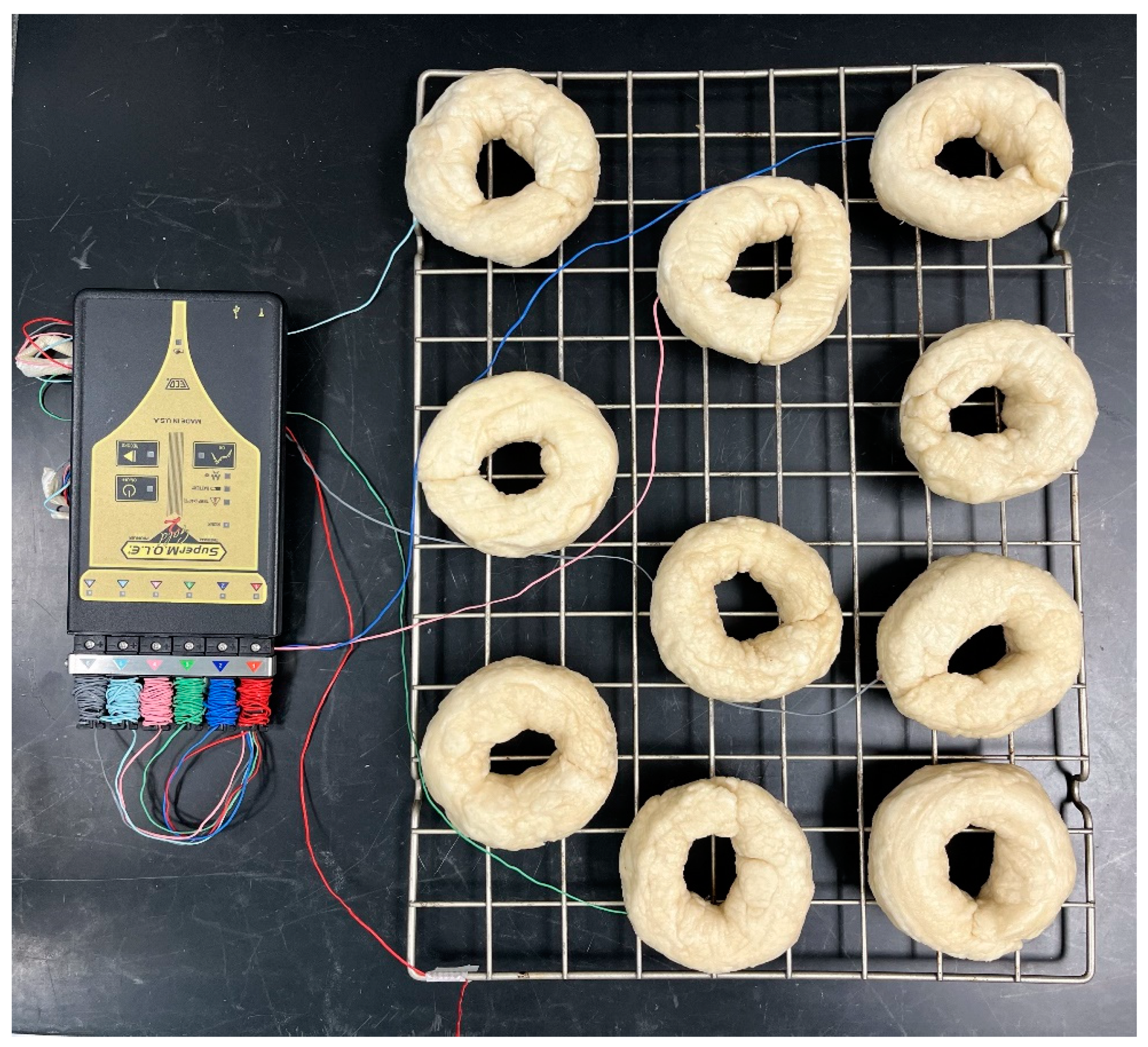
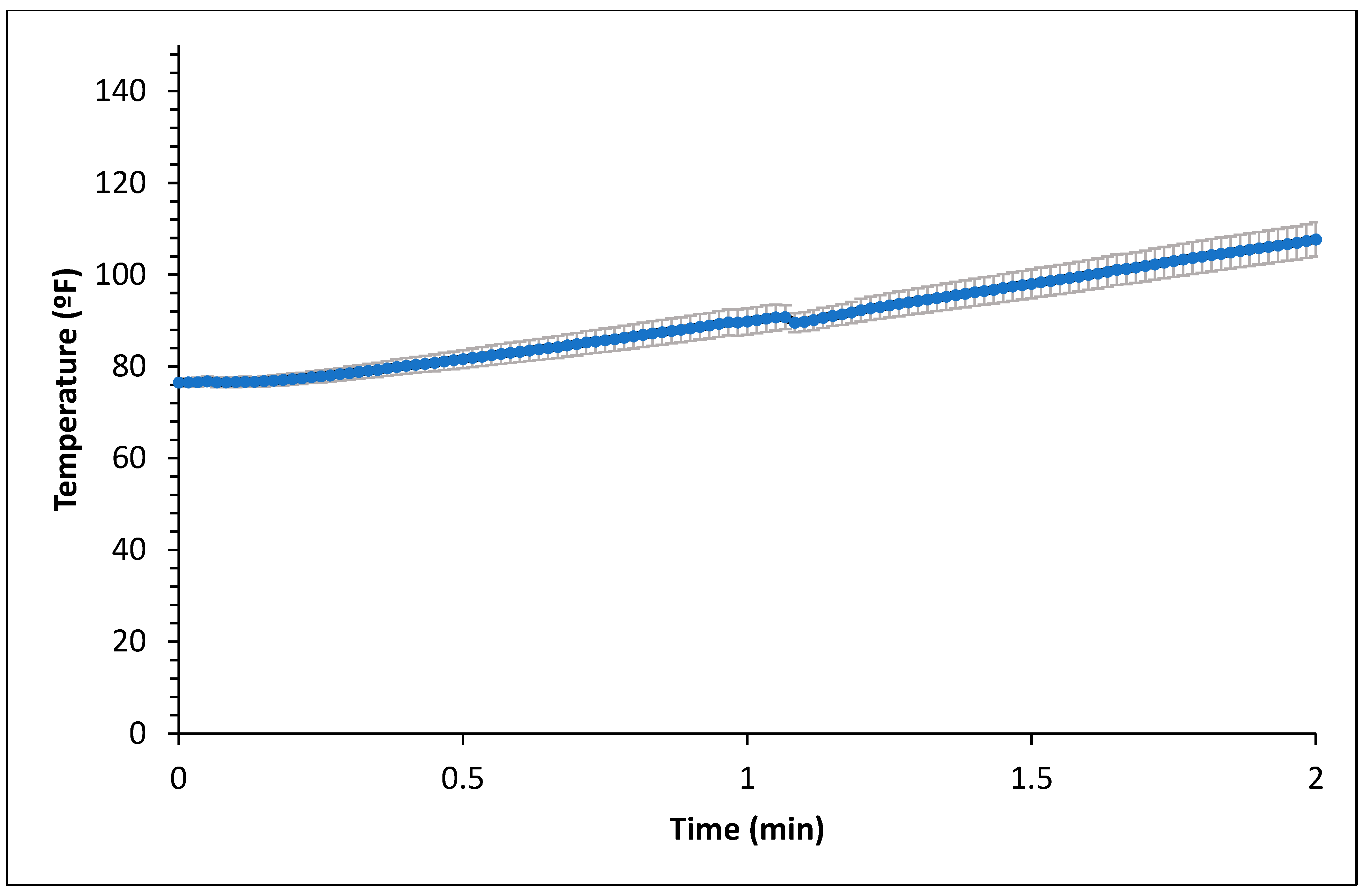
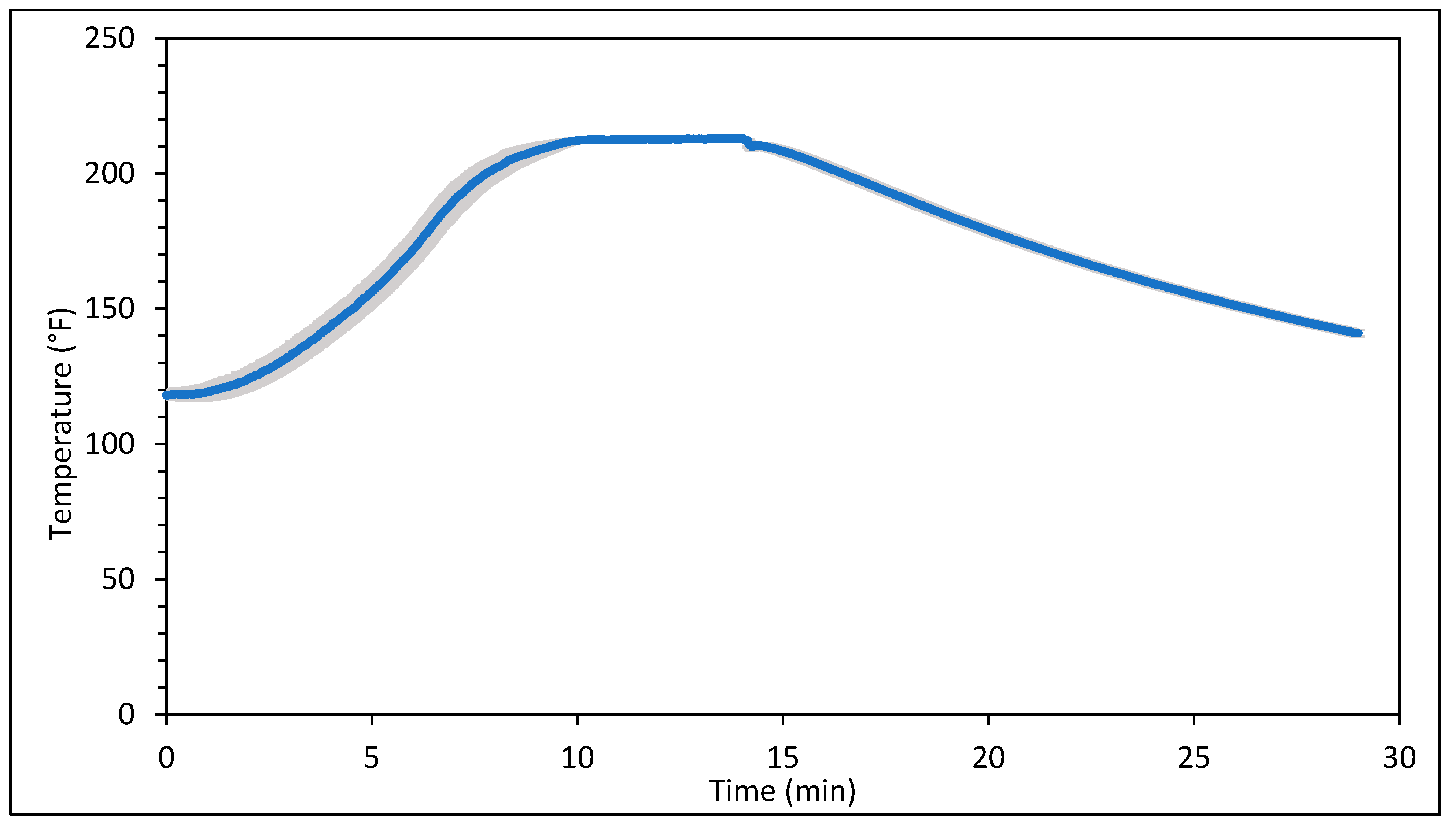
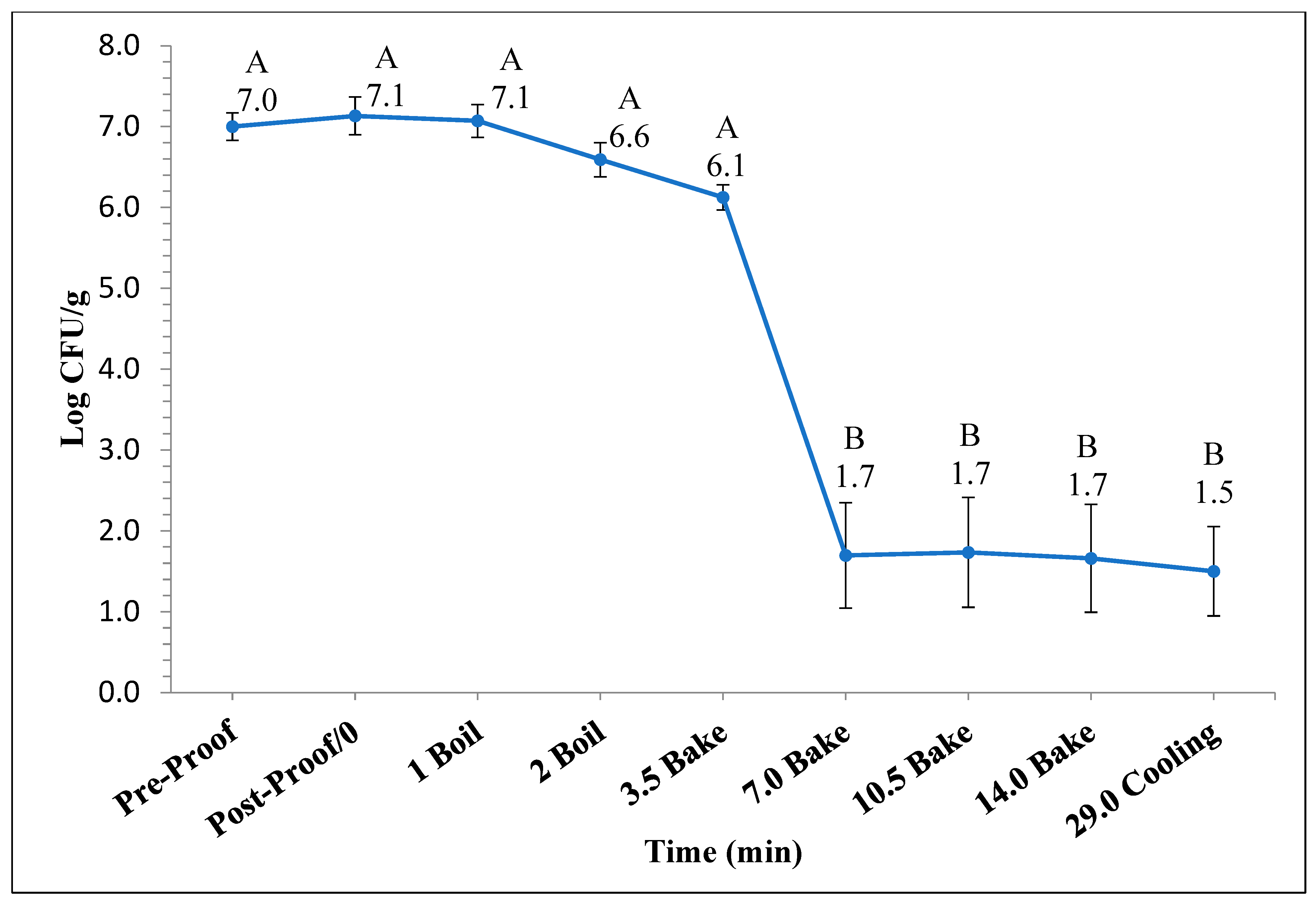
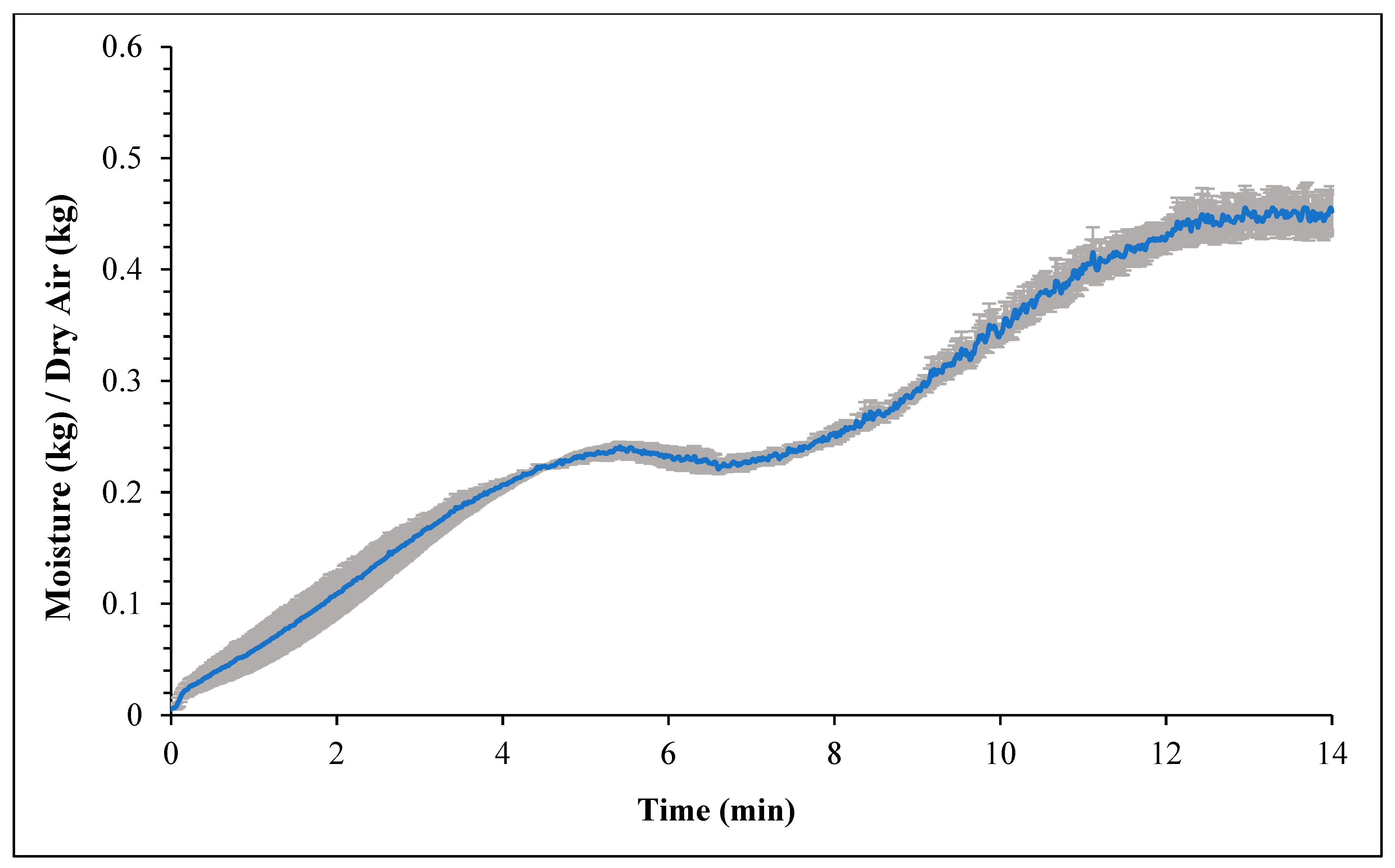

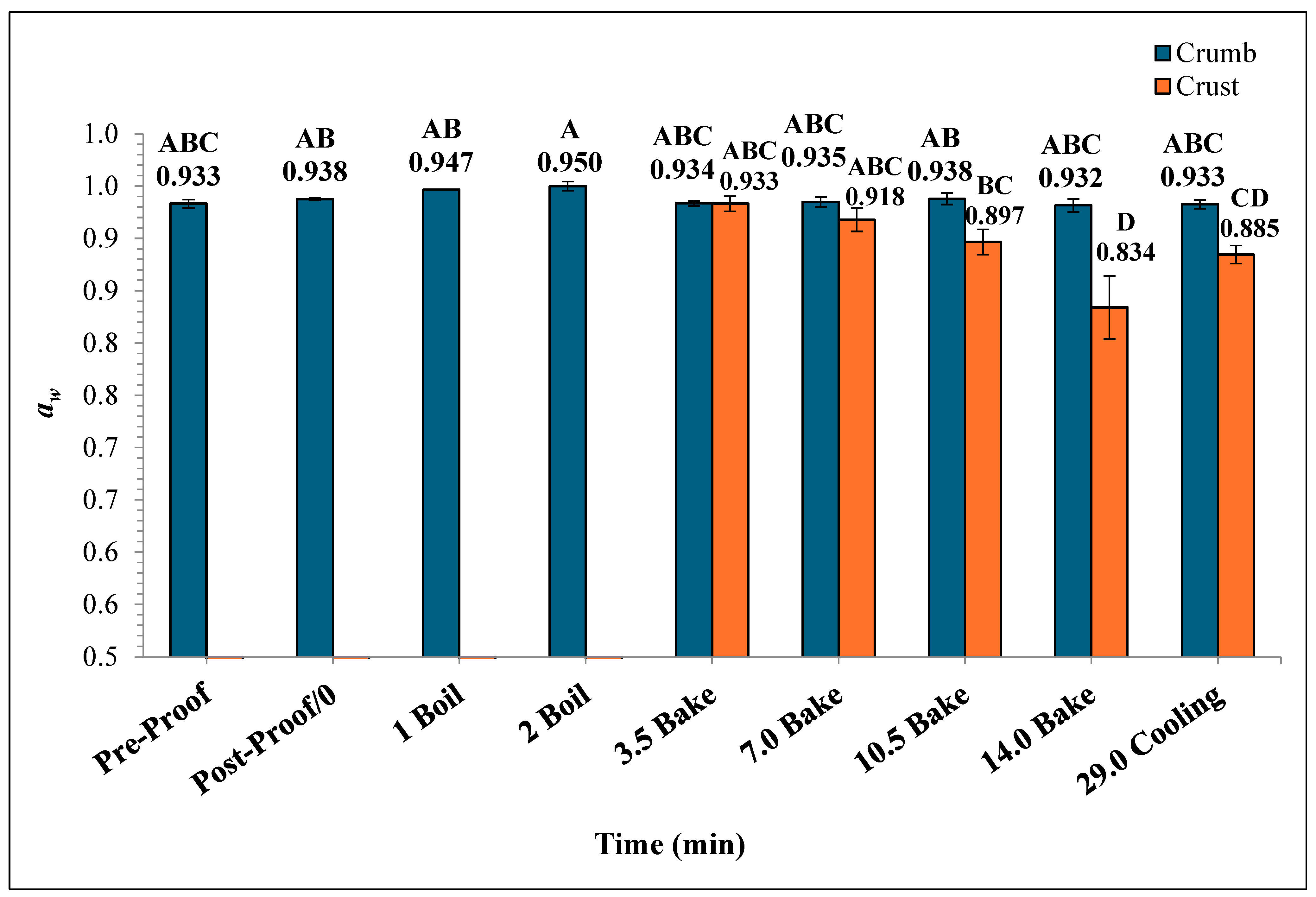


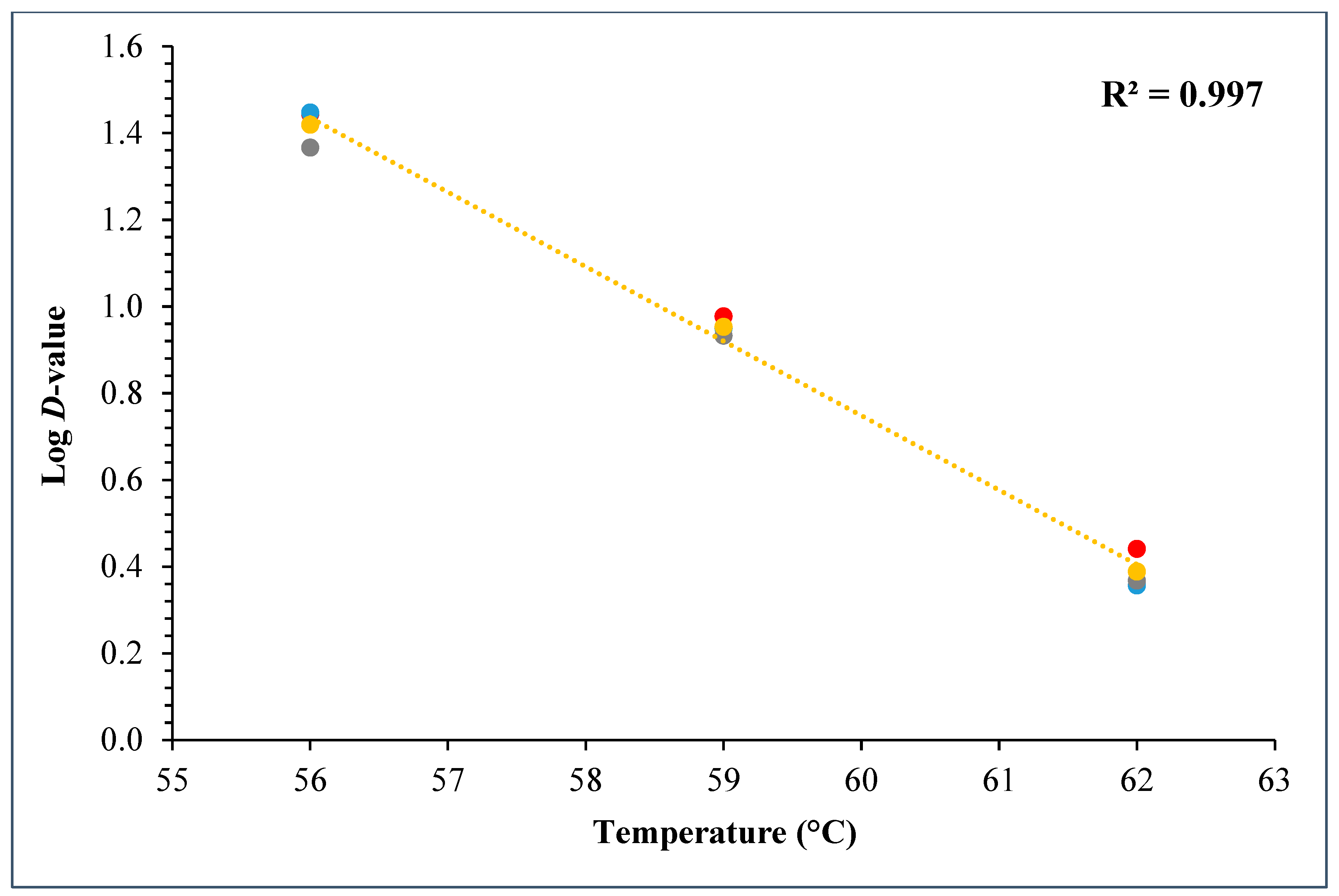
| Ingredient | Weight (g) |
|---|---|
| Inoculated bread flour | 700 |
| Sugar | 21 |
| Salt | 14 |
| Dry yeast | 5.6 |
| Water | 350 |
| Ingredient | Weight (g) |
|---|---|
| Inoculated bread flour | 140 |
| Sugar | 4.2 |
| Salt | 2.8 |
| Water | 70 |
| STEC | Strain | Origin |
|---|---|---|
| E. coli O157:H7 | ATCC 43895 | E. coli strain (CDC EDL 933) isolated from raw hamburger meat implicated in a hemorrhagic colitis outbreak |
| E. coli O157:H7 | ATCC 43894 | E. coli strain (CDC EDL 932) isolated from patient’s feces from outbreak of hemorrhagic colitis |
| E. coli O157:H7 | C7927 | E. coli strain isolated from a patient from an outbreak linked to contaminated apple cider (CDC) |
| E. coli O157:H7 | MF 1847 | Source: (USDA-FSIS). Originally isolated from hamburger meat, Food Microbiology Laboratory, Howard University, USA |
| E. coli O26:H11 | ATCC BAA-2196 | E. coli strain isolated from patient’s stool samples |
| Items | Shiga Toxin-Producing Escherichia coli |
|---|---|
| 56 °C | 26.3 ± 1.55 |
| 59 °C | 9.0 ± 0.27 |
| 62 °C | 2.5 ± 0.15 |
| z-value | 5.8 ± 0.16 |
Disclaimer/Publisher’s Note: The statements, opinions and data contained in all publications are solely those of the individual author(s) and contributor(s) and not of MDPI and/or the editor(s). MDPI and/or the editor(s) disclaim responsibility for any injury to people or property resulting from any ideas, methods, instructions or products referred to in the content. |
© 2025 by the authors. Licensee MDPI, Basel, Switzerland. This article is an open access article distributed under the terms and conditions of the Creative Commons Attribution (CC BY) license (https://creativecommons.org/licenses/by/4.0/).
Share and Cite
Hunt, C.; Singh, A.; Ramesh, D.; Channaiah, L.H. Validation of a Simulated Commercial Plain Bagel Baking Process and Thermal Resistance Characterization of a 5-Strain Shiga Toxin-Producing Escherichia coli When Introduced via Flour. Foods 2025, 14, 1218. https://doi.org/10.3390/foods14071218
Hunt C, Singh A, Ramesh D, Channaiah LH. Validation of a Simulated Commercial Plain Bagel Baking Process and Thermal Resistance Characterization of a 5-Strain Shiga Toxin-Producing Escherichia coli When Introduced via Flour. Foods. 2025; 14(7):1218. https://doi.org/10.3390/foods14071218
Chicago/Turabian StyleHunt, Conor, Arshdeep Singh, Drushya Ramesh, and Lakshmikantha H. Channaiah. 2025. "Validation of a Simulated Commercial Plain Bagel Baking Process and Thermal Resistance Characterization of a 5-Strain Shiga Toxin-Producing Escherichia coli When Introduced via Flour" Foods 14, no. 7: 1218. https://doi.org/10.3390/foods14071218
APA StyleHunt, C., Singh, A., Ramesh, D., & Channaiah, L. H. (2025). Validation of a Simulated Commercial Plain Bagel Baking Process and Thermal Resistance Characterization of a 5-Strain Shiga Toxin-Producing Escherichia coli When Introduced via Flour. Foods, 14(7), 1218. https://doi.org/10.3390/foods14071218






